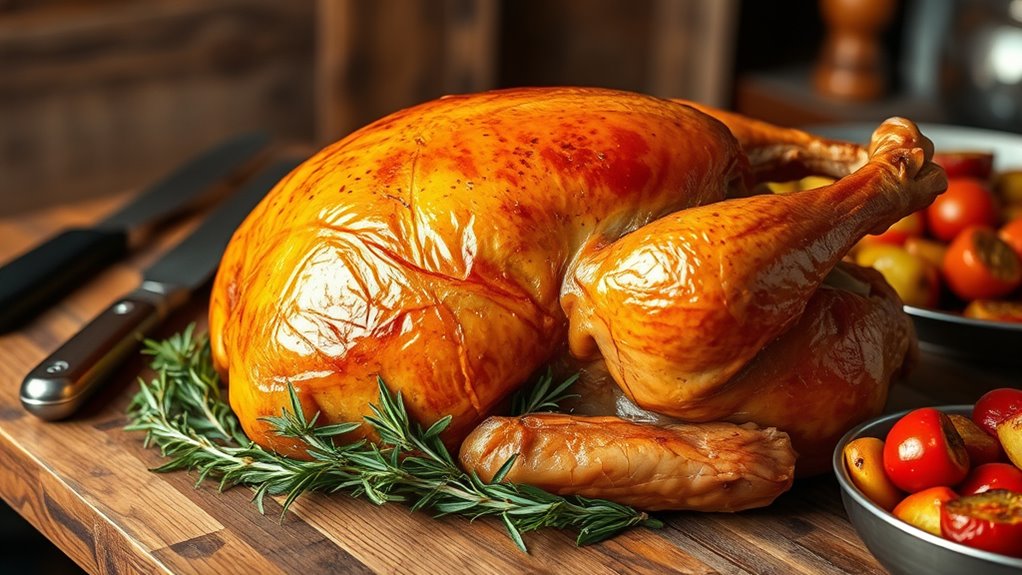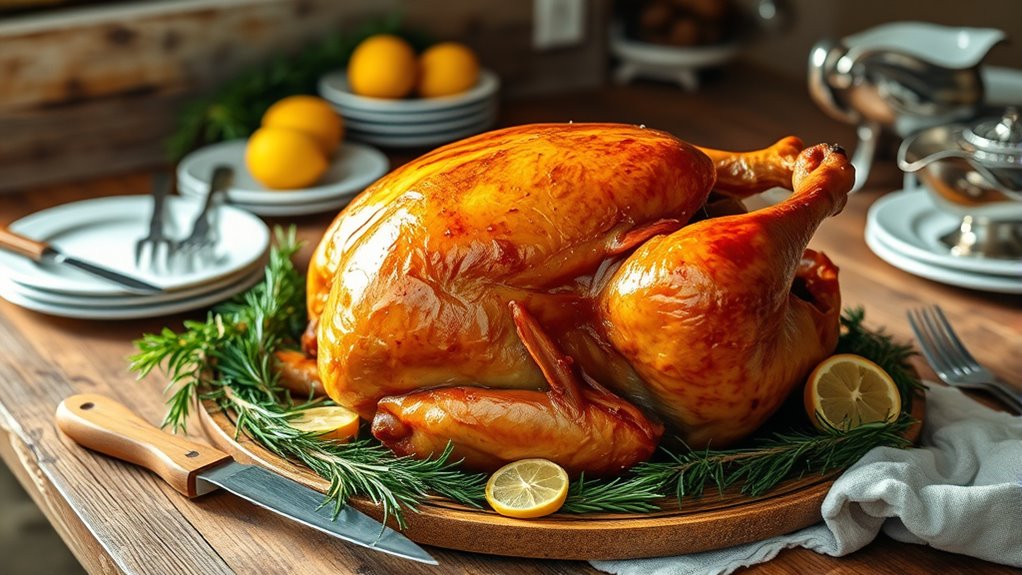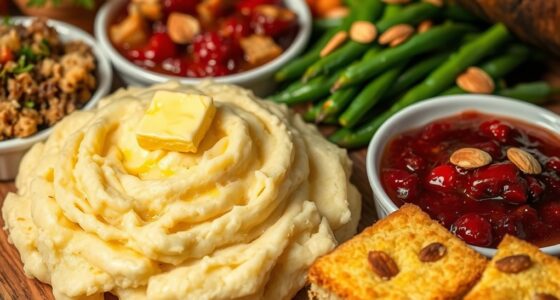To make a classic roast turkey, start by brining it to lock in moisture, either through a wet or dry method. Next, preheat your oven and season the bird with herbs and butter for extra flavor. Roast until the internal temperature reaches 165°F, then let it rest before carving. Carve against the grain into even slices for a beautiful presentation. Keep these steps in mind; you’ll discover more tips to perfect your turkey as you go.
Key Takeaways
- Brine the turkey (wet or dry) to enhance moisture and flavor before roasting.
- Preheat the oven to 325°F–350°F and season the turkey for even browning.
- Roast until the internal temperature reaches 165°F in the breast and thighs.
- Rest the turkey for 20 minutes post-roast to retain juices before carving.
- Carve the turkey carefully into slices against the grain for presentation and tenderness.

Are you ready to master the art of roasting a perfect turkey? It all begins with understanding the importance of brining methods. Brining helps guarantee your turkey stays moist and flavorful throughout the cooking process. You can opt for wet brining, which involves immersing the turkey in a saltwater solution infused with herbs, spices, and sometimes sugar. This method allows the meat to absorb moisture and seasoning, resulting in a juicy, tender bird. Alternatively, dry brining involves rubbing salt and seasonings directly onto the turkey’s skin and letting it rest in the fridge for 24 to 48 hours. Dry brining not only enhances flavor but also helps achieve crispier skin. Whichever method you choose, remember that proper timing is key—brine the turkey long enough to impart flavor but not so long that the texture becomes compromised. Once brining is complete, rinse the turkey if you’ve used a wet brine, then pat it dry thoroughly. A dry surface promotes even roasting and crispy skin.
Next, prepare your oven and get the turkey ready for roasting. Preheat the oven to the appropriate temperature, generally around 325°F to 350°F, depending on your recipe. Season the turkey further with herbs, spices, and butter or oil to enhance flavor and promote browning. When it’s time to carve, pay attention to your carving techniques. Proper carving starts with resting the turkey for about 20 minutes after it comes out of the oven—this helps the juices redistribute, making the meat easier to carve and more succulent. Use a sharp carving knife and start by removing the legs and thighs, slicing through the joint with smooth, controlled motions. Then, carve the breast meat by making long, even slices against the grain for tender, uniform pieces. Take your time, and don’t rush—careful carving not only improves presentation but also ensures each serving is flavorful and juicy.
Throughout the process, keep an eye on the turkey’s internal temperature, aiming for 165°F in the thickest part of the breast and thighs. Use a reliable meat thermometer to avoid under or overcooking. Once carved, arrange the slices neatly on a platter, and serve immediately to enjoy the full benefits of your effort. Remember, mastering brining methods and carving techniques transforms a simple roast into a show-stopping centerpiece. With practice, you’ll develop a rhythm that makes every step smoother and every meal more delicious. So, embrace the process, pay attention to detail, and enjoy the rewarding experience of serving a perfectly roasted turkey every time.
Frequently Asked Questions
Can I Prepare the Turkey a Day Ahead?
Yes, you can prepare your turkey a day ahead to simplify meal prep. After roasting, let it cool, then carve and store it in an airtight container in the fridge. Reheat gently before serving. This method also lets you experiment with flavor variations like different herbs or marinades. Just make certain the turkey stays moist and flavorful, so it tastes just as delicious as when freshly cooked.
What Are Alternative Herbs for Seasoning?
Imagine a fragrant garden of fresh herbs, waiting to elevate your turkey. You can swap thyme with rosemary for a piney aroma, or basil for a sweet, peppery note. For seasoning variations, try sage for earthiness or marjoram for a subtle, minty flavor. Herb substitutions allow you to customize your roast, creating a unique aroma and taste that perfectly complements your holiday feast.
How Do I Ensure the Turkey Stays Moist?
To keep your turkey moist, use brine techniques like soaking it in a saltwater solution beforehand. This helps with moisture retention, ensuring juicy meat. You can also baste the turkey regularly during roasting and cover it with foil if it starts to brown too quickly. Using a meat thermometer to avoid overcooking is essential. These methods work together to deliver a tender, flavorful, and moist turkey every time.
Is It Safe to Stuff the Turkey Beforehand?
Stuffing your turkey beforehand is like inviting bacteria to a party; it’s generally unsafe because it promotes bacterial growth and food safety risks. To keep everyone healthy, stuff the turkey just before roasting and guarantee the stuffing reaches 165°F. This way, you prevent harmful bacteria from thriving and serve a delicious, safe meal. Always follow food safety guidelines to keep your feast both tasty and secure.
What Are Gluten-Free Stuffing Options?
You can enjoy gluten-free stuffing options by using gluten-free bread or grain alternatives like quinoa, rice, or millet. Simply cube the gluten-free bread and mix it with sautéed vegetables, herbs, and broth, or cook your chosen grain and combine it with seasonings and vegetables. These options guarantee your stuffing is safe for gluten sensitivities while still being flavorful and satisfying. Feel free to experiment with different combinations!
Conclusion
Now that you’ve mastered the art of roasting a turkey, you’re ready to create your own holiday feast. Think of this recipe as your culinary North Star, guiding you through every step with confidence. With patience and care, you’ll craft a centerpiece that’s as memorable as the stories shared around the table. So go ahead—bring your own magic to the oven, and make this tradition your own, just like a true holiday legend in the making.









